Urban foraging offers rich rewards for jam makers. You'll find blackberries along fences, mulberries in parks, black raspberries near railways, and elderberries in green spaces. For best results, harvest fully ripe berries away from pollution, use low-sugar pectin techniques, and try creating medleys for unique flavors. Don't overlook invasive wineberries that make stellar preserves. These wild jams deliver both superior taste and health benefits beyond what store-bought varieties can offer.
10 Best Wild Berry Jams From City Harvests
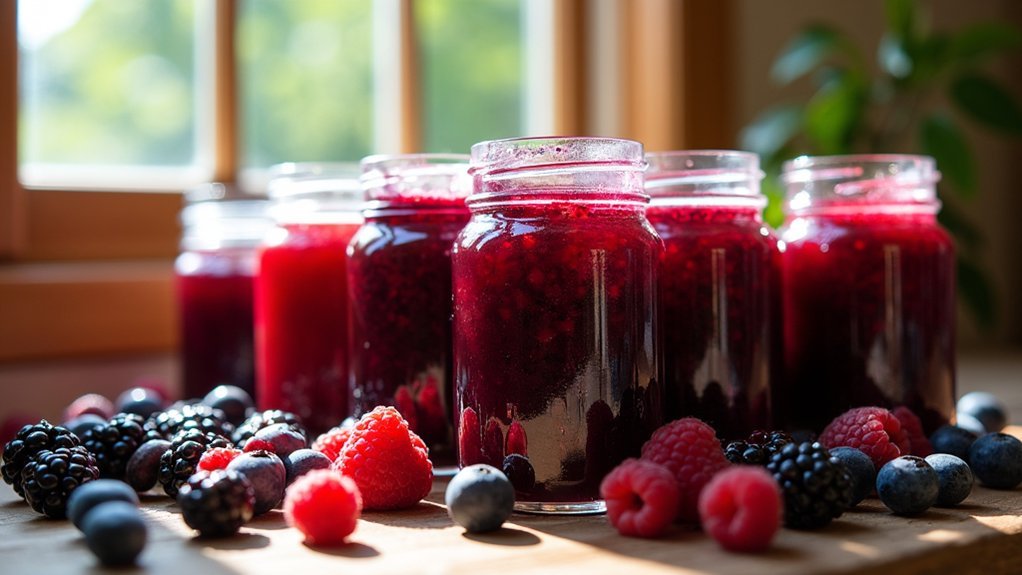
While many assume wild berries only grow in remote forests, urban environments actually offer abundant harvesting opportunities for jam-making enthusiasts. Wild blackberries, often thriving in city parks and along fences, make exceptional jams with their deep color and rich flavor.
Urban foragers rejoice—wild blackberries flourish in city spaces, offering rich flavors perfect for extraordinary homemade jams.
When processing your urban harvest, consider using low sugar pectin to let the natural sweetness shine through. This approach not only creates a healthier spread but also highlights the unique characteristics of city-grown berries.
Don't forget to strain seeds for smoother texture, especially with black raspberries.
Following proper canning techniques is crucial—maintain a hard boil, adjust processing time for your altitude, and verify jars seal correctly. These steps guarantee your wild berry jam remains safe and delicious year-round, preserving summer's bounty from unexpected city locations.
Urban Blackberry Bounty: Transforming Alleyway Finds
You'll need a sturdy basket, gloves, and pruning shears when collecting blackberries from urban alleys, making sure to harvest only from pesticide-free areas away from traffic pollution.
Always get permission before picking on private property, and check local regulations about foraging in public spaces to avoid potential fines.
When your kitchen space is limited, consider small-batch jamming with quarter-pint jars or freezer preservation methods that don't require traditional canning equipment.
Alley Foraging Essentials
Hidden between city buildings and behind forgotten fences, urban alleyways offer surprising bounty for wild food enthusiasts. When seeking blackberries, look for sprawling brambles in neglected corners where these resilient fruits thrive without human intervention.
Timing is everything in successful foraging. Select only deep black, plump berries that easily detach from the vine—typically from late summer through early fall. Always carry a sturdy container and wear protective gloves to shield against thorns.
Choose your gathering spots wisely. Avoid berries growing near busy streets, industrial areas, or where dogs frequently visit. Instead, seek patches in cleaner, less-trafficked zones to guarantee your jam ingredients remain uncontaminated.
With proper identification and location selection, you'll transform overlooked urban resources into pantry treasures that capture summer's essence year-round.
Urban Harvesting Safety
Urban harvesting brings excitement and rewards, but requires careful attention to safety and legal considerations. Before filling your basket with those tempting blackberries, make sure you have permission to harvest from the location you've discovered. Many urban patches grow on private property or in areas with specific regulations.
Always wear gloves to protect your hands from thorns and keep berries clean. Learn to properly identify wild blackberries by their thorny canes and distinctive arching growth pattern to avoid potentially harmful lookalikes. If you're interested in learning more about identification, local foraging guides can be invaluable resources.
Harvest during dry weather, preferably mid-morning after dew has evaporated. Avoid picking near busy roads where berries may contain pollutants.
Refrigerate your bounty immediately to preserve freshness for jam-making.
Space-Saving Preservation Techniques
Living in compact city spaces doesn't mean you can't preserve your alleyway blackberry treasures.
Small-batch canning techniques allow you to transform your urban harvest into delicious jams without specialized equipment. Try using a regular soup pot instead of a bulky canning pot—it's perfect for limited kitchen space and the smaller quantities typically gathered from city foraging.
Enhance your jam's flavor while reducing storage needs by using low sugar pectin. You'll create healthier preserves that maintain vibrant blackberry flavors with less added sugar.
Run your mixture through a food mill to remove seeds for smoother texture.
Don't forget to label each jar with the date and jam type. This simple organization system helps you track your preserves and maximize storage space, ensuring you'll enjoy your urban blackberry bounty throughout the year.
Mulberry Magic: Harvesting From City Parks
While many city dwellers stroll past fruit-laden mulberry trees without a second glance, these overlooked treasures offer a bounty of dark purple berries perfect for homemade jam.
You'll find these elongated, blackberry-like fruits ripening from late spring to early summer in parks throughout the city.
As an urban forager, timing is everything. Look for berries that have turned deep purple or black, indicating peak sweetness.
When harvesting mulberries, handle them gently to prevent bruising, and only collect fully ripe specimens—unripe ones are too tart for good jam.
Before filling your basket, check local regulations about foraging in public spaces.
The effort is worthwhile; mulberries transform beautifully into jam using standard canning methods with pectin and sugar, creating a uniquely urban wild preserve.
Wild Black Raspberry Preserves From Railway Edges

Three steps from the gravel paths along railway edges, you'll discover nature's hidden jewels—wild black raspberries that outshine their grocery store counterparts in both flavor and nutritional value. When foraging these vibrant berries, bring plenty of containers—you'll need them!
For perfect preserves, thoroughly mash your wild black raspberries to release their intense flavor. Using low sugar pectin creates a healthier jam while preserving the berries' natural tartness. Remember proper canning techniques guarantee shelf stability.
| Process Stage | Time Required | Key Technique |
|---|---|---|
| Harvesting | 1-2 hours | Pick only fully black berries |
| Preparation | 30 minutes | Mash completely for juice extraction |
| Cooking | 15 minutes | Maintain hard rolling boil |
| Processing | 10 minutes | Guarantee proper headspace in jars |
Elderberry Elixirs: Medicinal Jams From Urban Green Spaces
When foraging for elderberries in urban parks and green spaces, you'll need to identify bushes away from polluted areas and avoid those that may have been sprayed with pesticides.
The dark purple clusters you'll harvest contain potent immune-boosting compounds including vitamins A, C, and E that become especially valuable during cold and flu season.
You can transform these berries into medicinal jam by cooking them thoroughly with sugar, perhaps adding cinnamon or ginger to enhance both flavor and therapeutic benefits.
Urban Foraging Safety
Elderberry enthusiasts seeking nature's bounty in city landscapes must prioritize safety above all else.
When urban foraging, remember that proper identification is your first defense against toxicity. Elderberries require careful handling—they contain compounds that are poisonous when raw, but cooking thoroughly neutralizes these toxins.
Before collecting berries, verify that your chosen location hasn't been treated with pesticides or exposed to urban pollutants. These contaminants can transform your medicinal jam into something harmful.
Scout locations away from busy roads and industrial areas where pollution tends to concentrate.
Don't forget to research local regulations governing foraging activities. Many cities have specific rules about harvesting in public spaces.
Immune-Boosting Properties
Among nature's most potent medicinal treasures, elderberries stand out for their remarkable immune-enhancing qualities. These urban-foraged berries pack a powerful punch of antioxidants and vitamins A, B, and C, making them an exceptional immune booster during cold and flu season.
When crafting elderberry jam from your city harvest, remember to cook the berries thoroughly to neutralize their natural toxins. Raw elderberries can cause nausea and digestive discomfort, but proper preparation transforms them into safe, healing preserves.
For maximum health benefits, try adding ginger and cinnamon to your elderberry jam. These complementary spices enhance the antioxidant properties while contributing their own anti-inflammatory benefits.
You'll create not just a delicious spread but a medicinal food that can help reduce cold duration and strengthen your body's natural defenses.
Serviceberry Spreads: The Overlooked Street Fruit
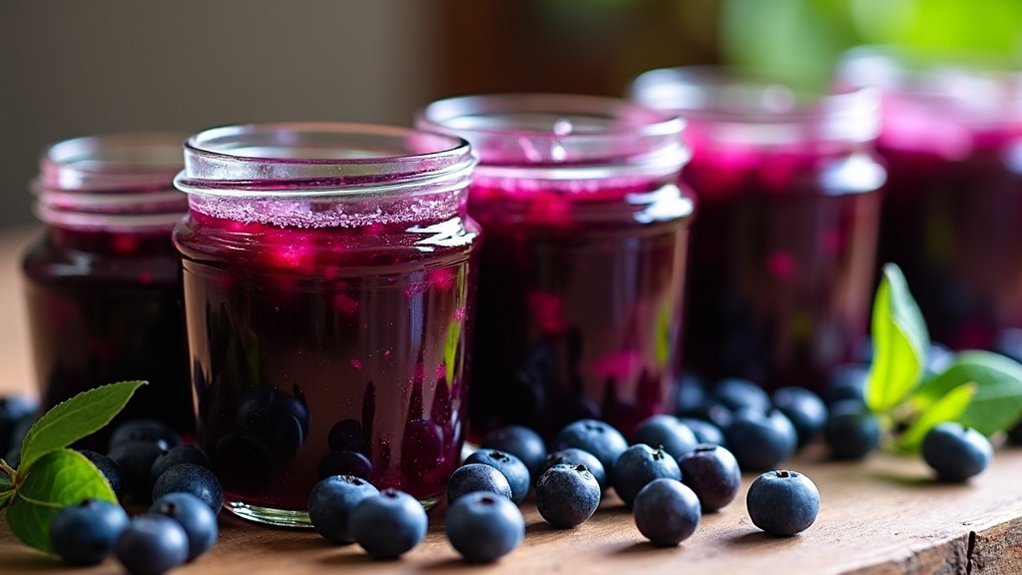
Hidden in plain sight along urban streets and parks, serviceberries offer a treasure trove of flavor possibilities for jam enthusiasts.
You'll recognize these urban fruits when they turn deep purple in late spring to early summer—that's your signal to start harvesting.
Making serviceberry jam is straightforward: mash these antioxidant-rich berries, mix with sugar and pectin, and watch as they transform into a vibrant spread with a unique blueberry-almond flavor profile.
The humble serviceberry transforms into culinary magic with just a mash, a mix, and a moment's patience.
Don't let these nutritional powerhouses go to waste!
Spread your homemade serviceberry jam on morning toast, swirl it into yogurt, or incorporate it into desserts.
While many pass by these Juneberries without a second glance, you'll now recognize them as one of the most versatile and healthy wild fruits available right in your neighborhood.
Low-Sugar Wild Jam Techniques For Healthier Preserving
Low-sugar preserving becomes simple when you're using the right pectin, which you'll mix with a portion of your total sugar before adding to your wild berry mixture.
You'll find that straining seeds through a food mill or sieve dramatically improves your jam's texture while maintaining the fruit's natural flavor profile.
For an extra flavor boost without additional sweetness, try incorporating cinnamon or vanilla extract to complement your berries' natural tartness.
Reduced-Sugar Pectin Benefits
While traditional jam recipes often call for equal parts fruit and sugar, reduced-sugar pectin has revolutionized home preserving by allowing wild berry enthusiasts to create healthier spreads without sacrificing texture or shelf life.
You'll find that this specialized pectin enables you to cut sugar by up to half while still achieving perfect gelling consistency.
To get ideal results, mix your reduced-sugar pectin with a portion of your sugar before adding it to your wild berries. This prevents clumping and guarantees even distribution throughout your jam.
The lower sugar content lets the natural flavors of blackberries and raspberries shine through, especially when using naturally sweet wild varieties.
Remember to maintain a hard boil during the cooking process—reduced-sugar pectin sets quickly, requiring shorter cooking times that better preserve the vibrant colors and fresh taste of your foraged fruits.
Seed Straining Methods
One major consideration when making low-sugar wild berry preserves is managing those tiny seeds—especially abundant in blackberries and raspberries.
When working with low-sugar pectin, you'll want clear, seed-free preserves that maintain vibrant flavor without overwhelming texture issues.
Three effective seed straining methods for your urban foraging bounty:
- Use a food mill with an appropriate screen size to separate seeds and skins while capturing all the valuable pulp for your preserves.
- Push your mashed berries through a fine-mesh sieve, pressing firmly to extract maximum juice and pulp.
- Process your wild berries through a tomato processor, which efficiently removes seeds while maintaining the fruit's rich color.
Remember to mix your low-sugar pectin with a portion of sugar before adding to your strained berry mixture—this guarantees proper gelling while maintaining the bright, natural flavors of your urban harvest.
Mixed Berry Medleys: Combining Urban Foraged Fruits
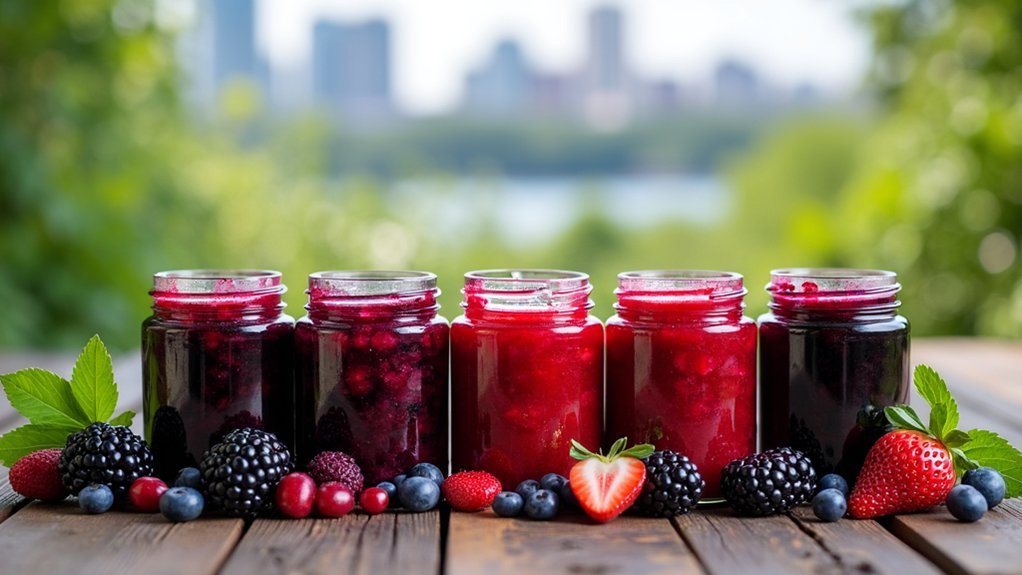
Why limit yourself to a single berry when the urban landscape offers a bounty of wild fruits waiting to be transformed into delicious jams? Urban foraging yields blackberries, raspberries, and elderberries that create vibrant mixed berry jams with unique flavor profiles. Aim for five cups of mashed berries for perfect consistency.
| Berry Type | Flavor Notes | Recommended % |
|---|---|---|
| Blackberry | Rich, earthy | 40-50% |
| Raspberry | Bright, tangy | 25-35% |
| Elderberry | Floral, deep | 15-20% |
| Mulberry | Sweet, mild | 10-15% |
| Salmonberry | Tart, complex | 5-10% |
Using low sugar pectin reduces sweetener while maintaining gel formation. Don't skip straining when working with multiple berry varieties—a food mill separates seeds while preserving the jam's vibrant character.
Wineberry Wonders: Asian Invasives Make Stellar Preserves
Despite their invasive status, wineberries offer foragers a spectacular opportunity to create unique, ruby-red preserves with minimal effort.
You'll find these Asian berries thriving along forest edges and in thickets throughout urban and suburban areas, making them perfect for your next foraging expedition.
When crafting wineberry jam, you'll appreciate their natural high pectin content—no additives needed for that perfect consistency:
- Combine wineberries with blackberries or raspberries to develop complex flavor profiles
- Utilize their distinctive tart sweetness for vibrant, flavorful preserves
- Experiment beyond basic toast spreads—try your wineberry preserves as toppings for yogurt, ice cream, or incorporate them into savory marinades
These versatile preserves transform a problematic invasive into a delicious pantry staple you'll reach for year-round.
Seed Separation Methods For Smoother City Fruit Jams
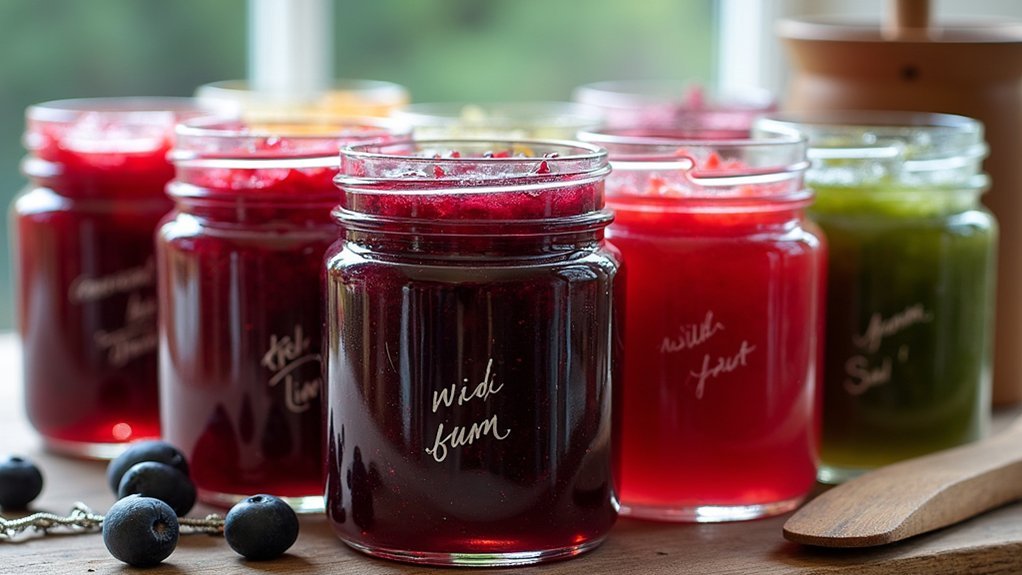
While wineberries offer exceptional flavor with minimal effort, many city-foraged berries present a common challenge—those tiny, crunchy seeds that can detract from an otherwise perfect jam experience.
You'll achieve smoother city fruit jams by employing effective seed separation methods during preparation. Start by breaking down your berry mixture with a potato masher, which makes seeds easier to remove later.
For thorough seed removal, process your mashed berries through a food mill or sieve, effectively separating seeds while preserving the fruit's vibrant color and flavor.
Don't have a food mill? Try a tomato processor—an excellent tool that retains juice and pulp while eliminating skins and seeds.
Alternatively, simply strain your berry mixture after mashing to greatly reduce seed content and enhance your jam's texture.
Frequently Asked Questions
Are Wild City Berries Safe From Pollution and Pesticides?
Wild city berries carry risks from pollution, pesticides, and environmental contaminants. You'll need to thoroughly wash them and consider their growing location. It's safest to harvest from areas away from busy streets and industrial zones.
How Long Can Properly Canned Wild Berry Jams Last?
Properly canned wild berry jams can last up to 2 years when stored in a cool, dark place. You'll get the best flavor in the first year, but they're safe to eat much longer.
What Permits Might I Need for Harvesting in Public Spaces?
You'll likely need foraging permits from local parks, urban forestry, or municipal authorities. Check city ordinances before harvesting, as many places require specific licenses. Don't forget to verify seasonal restrictions and harvesting limits too.
Can Pregnant Women Safely Consume Foraged Berry Preserves?
You can enjoy foraged berry preserves during pregnancy, but make certain they're properly prepared to kill pathogens. Avoid uncooked preserves, wash berries thoroughly, and verify they're correctly identified. When in doubt, consult your healthcare provider.
How Do I Identify Poisonous Berries That Resemble Edible Varieties?
You'll need to learn key visual differences between poisonous and edible lookalikes. Check for distinctive leaf patterns, growth structure, and berry attachment. Don't rely on color alone. When uncertain, consult a field guide or expert.
In Summary
Urban foraging puts overlooked treasures right at your fingertips. You've now discovered how city-grown berries transform into exceptional preserves that rival any store-bought variety. By harvesting what's already growing around you, you're connecting with your environment while creating something delicious. Next time you spot berries growing through a fence or alongside a path, you'll see them differently—as your next jar of remarkable homemade jam.

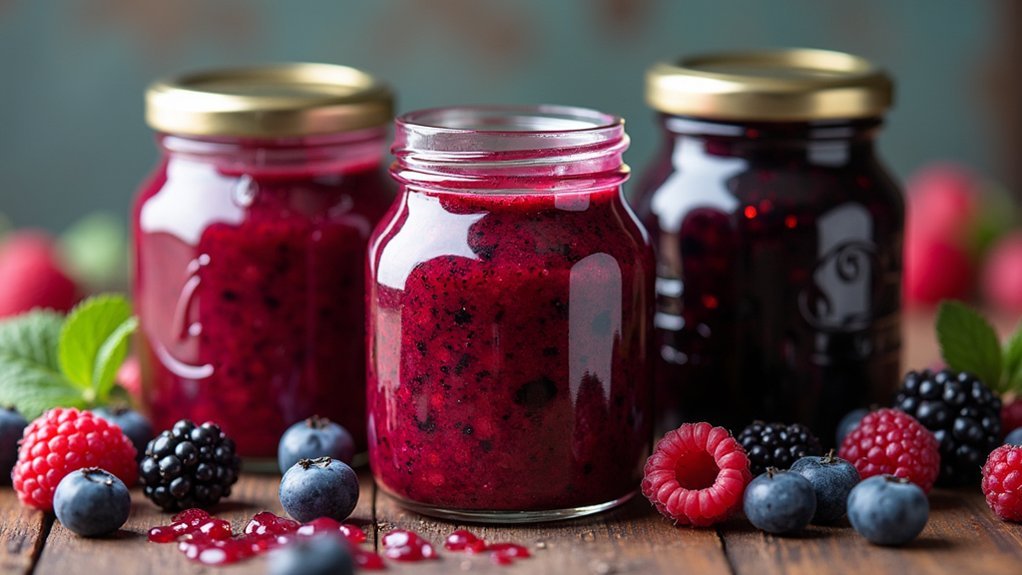



Leave a Reply